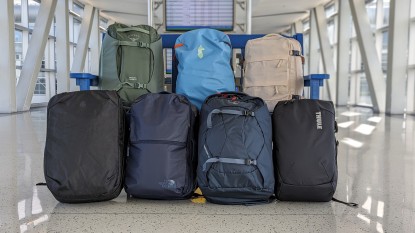Here at GearLab, we know what you might be thinking: What makes underwear travel underwear? Well, travel underwear is meant to move. Usually constructed with synthetic materials or wool, travel undies are designed to combat moisture and odor while keeping you comfortable day after day. They need to be versatile enough for different activities while offering enough breathability and quick-drying capabilities so that you can be comfortable just about anywhere. In this article, we explain these traits to help you navigate the market.
Let's Talk About Cotton
None of the many pairs of undies tested in this review are cotton, and that is intentional. Cotton has a few major downsides for active use: it's slow to dry, generally less durable, and can tend to stretch out after use.
Also, because our underwear has significant skin contact, any sweaty activity is going to force your cotton undies to absorb quite a bit of moisture. Cotton can be breathable, but it's generally not going to wick moisture away like other materials. And because we generally wear our underwear under other garments, they can take a long time to dry. Wet underwear = cold, wet skin, which can be a major issue in the backcountry without the option to change.
On top of this, getting your cotton undies damp will cause them to stretch out, and if you're committed to the same pair for multiple days, whether you're on a backpacking trip or a long flight around the world, this could cause discomfort and chafing.
On the other hand, cotton has a few great qualities. It's breathable and natural, which is why some gynecologists suggest cotton for women's undergarments. Great for everyday use, they just aren't our recommendation for travel and active use.
So, What Should I Do?
After months (and collectively years) of testing, we've learned that travel undies definitely have their place. But so does cotton. Our favorite travel method is a combination: we wear our fancy travel undies all day and then swap them out for a pair of loose, cotton underwear at night. We find this to be the best of both worlds, both from a health standpoint as well as a price standpoint. Since the average price of products in this review is kind of high, we also know that many of our readers may just pick one fancy pair and stick with it. So which one should you choose?
Synthetic vs. Wool
We tested products made of Merino wool and synthetic materials. The synthetics mainly consist, singularly or in a combination, of nylon, spandex, Lycra, and polyester. All materials have their pros and cons. Not sure which direction to go? Let us explain some of the differences between natural and synthetic fibers.
Synthetic
Synthetic materials like nylon, spandex, Lycra, polyester, and elastane are manufactured materials that excel in activewear. They are generally very good at wicking moisture and drying quickly, two incredibly important characteristics in travel underwear selection. They also can be quite durable, usually more so than wool or cotton. Lycra, spandex, and elastane are often included in underwear and base layers to incorporate more stretch into the garment, which is one thing we really liked about our favorite undies.
On the flip side, synthetic materials are known for their odor retention. That said, the days of permanently smelly undergarments are long gone. Most of these garments included some form of added odor prevention. Odor buildup is caused by bacteria accumulating in the material when it becomes saturated with perspiration. To prevent this moisture buildup, manufacturers have started including treatments in their garments designed to prevent this odor-causing bacteria from being able to grow. We had varying experiences with these treatments — most were not successful at keeping odor at bay, though some performed well, resisting odor buildup throughout our extensive testing period. Still, if odor control is one of your chief concerns, you may want to avoid synthetic materials.
Wool
Natural materials like wool can make for excellent base layers and undergarments. Each wool garment we tested has a unique texture and fit. Wool is especially good at odor prevention as its natural fibers are inherently odor-resistant. Wool is better at wicking moisture than cotton but is usually not as good as most synthetics.
One problem with wool is that it takes a bit longer to dry, which we found to be true in our drying time tests. That being said, the thinner Merino wool seemed to be comparable to slightly thicker synthetic materials, so this may not be a significant enough difference to change your purchasing preferences. The last problem with wool is that, in general, it's not as durable as synthetics. While our months of testing were not enough to cause any visible wear-and-tear in most of these products, we'd fully expect to have to retire the wool pairs first, even if it is years down the line.
Finding the One
To begin this review, we did hours upon hours of market research. From there, we picked the most compelling products, looking to span a price range and include various material types. Once we had all the products in hand, we started testing. Our team spent months wearing these products everywhere, from the alpine wonderland of Tuolumne Meadows in California to the sandstone paradise of Indian Creek in Utah and back to a very hot and humid Yosemite Valley. Through this process, we identified the most important qualities in a pair of travel undies and used these metrics to judge each product against its competitors.
Comfort and Fit
Our underwear has more skin contact than nearly any other product that we wear, so we knew right away that comfort would be important. What we learned was that this can take a variety of forms. We decided on a few traits that would help us develop an overall score for comfort: softness vs. itchiness, material thickness, and breathability.
The first thing we looked at, and the first thing we think you should look at, is how soft the material is. This is a bit subjective, so we highly recommend checking out these products in person before purchasing. Overall, we awarded the highest scores for products that had a silky smooth feeling. Thickness varied, but overall, we liked the thinner materials better.
A key component of comfort is the overall fit, so we looked at the sizing, seams, waistbands, leg openings, stretchiness, cut, and, yes, wedgies. So many things have to come together for a product to get a high score in this category. It needed to be stretchy without compromising security, and it had to provide coverage without sacrificing comfort. But the biggest test was the wedgie test. We ran, biked, hiked, practiced yoga, and climbed, trying to get these undies to shift around on us. Some were instant wedgie makers, while others stayed in place no matter what we did. Taking into consideration the softness next to the skin, as well as the overall fit, we awarded higher scores to those travel undies that were able to excel in both.
These Undies Cost How Much?!
We know, we know: many of these products may cost more than you're used to spending on underwear. And to be honest, our lead tester spent years doing all her big objectives in the same pair of synthetic undies because it felt like too much of a splurge to have multiple pairs. We hear you, and if this is how you're feeling, we have a solution. Just get one pair. We don't think that travel underwear is necessary for everyday wear, but it can make a big difference for long missions in the mountains or for extended trips. Try them on in person if you can to make sure you're getting the best fit, and take a serious look at the seams and overall construction to note any potential weak spots. If you're okay with a synthetic option, consider that it will also likely last longer than a more delicate wool pair.















